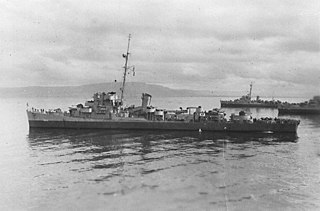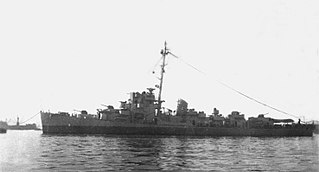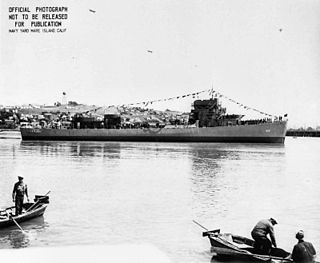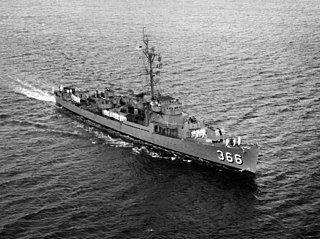
USS Grayson (DD-435), a Gleaves-class destroyer, is the only ship of the United States Navy to be named for Rear Admiral Cary Travers Grayson, who served as personal physician and aide to President Woodrow Wilson during World War I. He also served as chairman of the American Red Cross from 1935 until his death on 15 February 1938.

USS Bull (DE-693/APD-78) was a Buckley-class destroyer escort, later converted to a Charles Lawrence-class high speed transport. She was the second Navy ship named after Lieutenant Richard Bull (1914–1942), a naval aviator who was posthumously awarded the Distinguished Flying Cross.

USS Steele (BDE-8/DE-8) was an Evarts-class short-hull destroyer escort in the service of the United States Navy.

USS Sederstrom (DE-31) was a Evarts-class destroyer escort of the United States Navy during World War II. She was promptly sent to the Pacific Ocean to escort convoys and to protect other ships from Japanese planes and submarines. Her assignments took her from one battle area to another, but she was fortunate in remaining almost unscathed by the end of the war. For her efforts in battle areas, she was awarded five battle stars by war's end.

USS Burden R. Hastings (DE-19) was an Evarts-class destroyer escort of the United States Navy during World War II. Immediately after being built, she was crewed and sent to the Pacific Ocean to escort convoys and to protect them from air and submarine attack. During her wartime service, she was credited with having sunk one Japanese submarine and otherwise protecting numerous ships from danger. She was awarded four battle stars for her services in battle areas.
The second USS Dempsey (DE-26) was an Evarts-class destroyer escort constructed for the United States Navy during World War II. She was promptly sent off into the Pacific Ocean to protect convoys and other ships from Japanese submarines and fighter aircraft. By the end of the ship's World War II service career, when she returned to the United States, she had accumulated three battle stars.

USS Emery (DE-28) was an Evarts-class destroyer escort constructed for the United States Navy during World War II. It was promptly sent off into the Pacific Ocean to protect convoys and other ships from Japanese submarines and fighter aircraft. By the end of the war, she had accumulated three battle stars.

USS Donaldson (DE-44) was an Evarts-class destroyer escort of the United States Navy during World War II. She was sent off into the Pacific Ocean to protect convoys and other ships from Japanese submarines and fighter aircraft. She performed escort and anti-submarine operations in dangerous battle areas and was awarded seven battle stars, a very high number for a ship of her type.

USS Cabana (DE-260) was an Evarts-class destroyer escort constructed for the United States Navy during World War II. The namesake of this ship, Napoleon Joseph Cabana, was born in Fairhaven, Massachusetts on 26 March 1911, Cabana enlisted in the Navy on 17 March 1930 and was appointed machinist on 2 February 1941. As assistant safety engineer of the Cavite Navy Yard, Philippines, he was killed in action during Japanese attacks on that base on 12 December 1941.

USS Lake (DE-301) was an Evarts-class destroyer escort of the United States Navy during World War II. She was sent off into the Pacific Ocean to protect convoys and other ships from Japanese submarines and fighter aircraft. She performed escort and antisubmarine operations in dangerous battle areas and returned home with two battle stars.

USS Rall (DE-304) was an Evarts-class destroyer escort of the United States Navy during World War II. She was sent off into the Pacific Ocean to protect convoys and other ships from Japanese submarines and fighter aircraft. She performed escort and anti-submarine operations in dangerous battle areas and returned home with three battle stars.

USS Booth (DE-170) was a Cannon-class destroyer escort built for the United States Navy during World War II. She served in the Atlantic Ocean and then the Pacific Ocean and provided escort service against submarine and air attack for Navy vessels and convoys.

USS Bangust was a Cannon-class destroyer escort in service with the United States Navy from 1943 to 1946. In 1952, she was sold to Peru, where she served as BAP Castilla (D-61). She was decommissioned and scrapped in 1979.

USS Lamons (DE-743) was a Cannon-class destroyer escortin service with the United States Navy from 1944 to 1946. She was sold for scrapping in 1973.

USS Swenning (DE-394) was an Edsall-class destroyer escort in service with the United States Navy from 1943 to 1946. She was sold for scrapping in 1974.

USS Alvin C. Cockrell (DE-366) was a John C. Butler-class destroyer escort in service with the United States Navy from 1944 to 1946 and from 1951 to 1968. She was finally sunk as a target in 1969.

USS Straus (DE-408) was a John C. Butler-class destroyer escort in service with the United States Navy from 1944 to 1947. She was finally sunk as a target in 1973.

USS McCoy Reynolds (DE-440) was a John C. Butler-class destroyer escort acquired by the U.S. Navy during World War II. The primary purpose of the destroyer escort was to escort and protect ships in convoy, in addition to other tasks as assigned, such as patrol or radar picket. Post-war, after operating in the Pacific Ocean battle areas, her crew members returned home with four battle stars to their credit for World War II and one for the Korean War.

USS William C. Cole (DE-641) was a Buckley-class destroyer escort of the United States Navy, named in honor of Vice Admiral William C. Cole (1868–1935).
The BRP Datu Sikatuna (PF-5) was one of the three ex-USN Cannon-class destroyer escorts that served with the Philippine Navy, the others being BRP Datu Kalantiaw (PS-76) and BRP Rajah Humabon (PF-11).


















